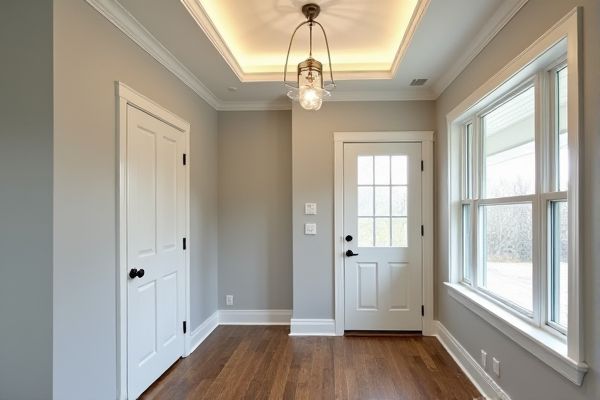
A mudroom tray ceiling adds architectural interest and a sense of spaciousness compared to a flat ceiling's simplicity and cost-effectiveness. Explore the rest of the article to discover how each ceiling style can enhance Your mudroom's functionality and aesthetic appeal.
Table of Comparison
| Feature | Mudroom Tray Ceiling | Flat Ceiling |
|---|---|---|
| Design | Recessed, layered with depth and architectural interest | Plain, smooth, and uniform surface |
| Visual Impact | Adds elegance and a sense of spaciousness to the mudroom | Simple and minimalistic, offering a clean look |
| Installation Complexity | More complex, requires skilled craftsmanship and additional materials | Simple to install with standard framing and drywall |
| Cost | Higher due to design details and labor | Lower, budget-friendly option |
| Maintenance | May need regular upkeep to maintain paint and detailing | Easy to maintain and clean |
| Lighting Options | Supports indirect and layered lighting like cove lights | Limited to surface-mounted or recessed lights |
| Space Perception | Enhances ceiling height perception, making room feel larger | Neutral effect on room size perception |
Introduction to Mudroom Ceiling Options
Mudroom ceiling options typically include tray ceilings and flat ceilings, each offering distinct aesthetic and functional benefits. Tray ceilings add architectural depth and can make small mudrooms feel more spacious, while flat ceilings provide a clean, simple look that is easier to maintain and install. Selecting between these ceiling types depends on design preferences, ceiling height, and the desired visual impact in the mudroom space.
What Is a Tray Ceiling?
A tray ceiling features a recessed central section that adds depth and architectural interest to your mudroom, contrasting with the uniform height of a flat ceiling. This design creates an illusion of increased space and can incorporate lighting or decorative molding for enhanced aesthetics. Choosing a tray ceiling in your mudroom elevates the room's style while maintaining practical functionality.
What Is a Flat Ceiling?
A flat ceiling features a smooth, horizontal surface that runs parallel to the floor, offering a clean and simple aesthetic commonly found in mudrooms for maximizing space and ease of lighting installation. This design contrasts with a tray ceiling, which has a recessed or inverted section adding depth and architectural interest, but flat ceilings provide a more practical, cost-effective solution for low-traffic entry spaces like mudrooms. Flat ceilings also facilitate straightforward HVAC and electrical modifications, enhancing functionality in high-use areas.
Aesthetic Impact: Tray vs Flat Ceilings
A mudroom tray ceiling enhances aesthetic appeal by adding depth and architectural interest, creating a more dynamic and upscale look compared to a flat ceiling's simple and streamlined appearance. The recessed design of tray ceilings allows for creative lighting options that emphasize texture and space, elevating the overall ambiance of your mudroom. Flat ceilings, while offering a clean and minimalistic look, may feel less visually engaging and lack the dimensionality that a tray ceiling can provide.
Space and Perception: Which Makes the Mudroom Feel Bigger?
A mudroom tray ceiling creates an illusion of increased height and depth, making the space feel more open and spacious compared to a flat ceiling. The recessed design draws the eye upward, enhancing perception of vertical space without expanding the actual footprint. When optimizing your mudroom for a larger feel, choosing a tray ceiling helps maximize spatial perception efficiently.
Installation Complexity and Cost Comparison
Mudroom tray ceilings require more intricate framing and drywall work, leading to higher installation complexity compared to flat ceilings, which involve straightforward finishes. The additional labor and materials for recessed lighting or crown molding in tray ceilings typically increase the cost by 20-35% over standard flat ceiling installations. Homeowners should budget accordingly, considering that tray ceilings offer enhanced aesthetic value but demand skilled labor and longer project timelines.
Lighting Possibilities in Tray and Flat Ceilings
Tray ceilings in mudrooms offer enhanced lighting possibilities by allowing recessed lights or LED strips to be installed within the ceiling's recessed tiers, creating layered illumination and a visually dynamic effect. Flat ceilings typically support standard flush or semi-flush mount fixtures, providing uniform, direct lighting but lacking the depth and architectural interest of tray ceiling lighting options. The choice between tray and flat ceilings significantly influences the ambiance and brightness versatility in mudroom design, with tray ceilings enabling more creative and customizable lighting schemes.
Maintenance and Cleaning Considerations
Mudroom tray ceilings offer easier maintenance due to their recessed design, which helps prevent dust accumulation compared to flat ceilings. Flat ceilings typically require more frequent cleaning as their larger, uninterrupted surface can collect dust and cobwebs more quickly. Your choice between these ceiling types can impact the time and effort needed for routine cleaning in your mudroom.
Resale Value: Which Ceiling Option Adds More Appeal?
A mudroom tray ceiling enhances resale value by adding architectural interest and a sense of spaciousness that flat ceilings often lack. Homebuyers typically appreciate the unique design and perceived luxury, making your home stand out in the market. Choosing a tray ceiling can elevate your home's appeal, potentially leading to a higher selling price.
Choosing the Right Ceiling for Your Mudroom
Selecting the ideal ceiling for your mudroom depends on the room's size, style, and functionality. A tray ceiling adds depth and architectural interest, making small mudrooms feel more spacious and upscale, while flat ceilings offer simplicity and ease of maintenance. Consider factors like lighting options, mold resistance, and integration with storage solutions to ensure your mudroom ceiling complements both design and practical needs.
 homyna.com
homyna.com